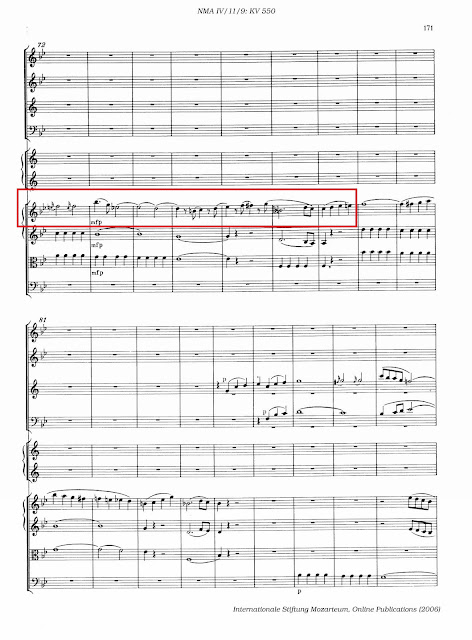CCCXCIV. MOZART, Wolfgang Amadeus (1756-1791)
- See Post XCV for the concept of #39-41 being a trilogy.
- Of all 41 symphonies, only two are in a minor key, and both in G Minor (the other is #25, K. 183).
- Mozart completely re-scored the wind parts, after having decided to add clarinets (which were just being developed into what we know as the modern clarinet). This score shows you where Mozart made the changes.
- It is uncertain whether Mozart actually got to hear a performance of this magnificent work ...
First Movement
Naturally a little gloomy (minor key), the descending theme nevertheless conveys a sense of optimism as it rises, only to fall again:
He decorates the second appearance of the theme with winds:
This second chromatic theme moves to the relative major -- B-Flat. Look how he divides this between strings and winds!
Development: Following a tutti tonic chord followed by a diminished seventh, Mozart weaves his way into a modulation in F-Sharp Minor!
In the following pages, Mozart whizzes through a variety of key changes -- breaking up the thematic motif into small pieces -- and then the recap -- finally -- reappears in G Minor completely unexpectedly:
and the movement closes with a tutti I-V progression:
Second Movement
A lyrical 6/8 in the key of E-Flat Major (the submediant). Check out all the leading tones Mozart uses to enrich the music; and the quick little 32nd-notes:
A move to B-Flat Major:
Section two begins with a surprise chromatic movement suggested a far-off A-Flat Minor -- the 32nd-note riff is now prominent -- and the bass rises chromatically until we reach the tonic major:
Third Movement
Not a minuet you are likely to dance to ... notice how the theme is divided into measures of three, then four:
The next section is fantastically imaginative -- the violins decorate the theme (in the winds) with a different phrase, and soon he has the violins playing in staggered entrances:
The Trio (G Major) is more danceable, very Haydn-like, except Mozart uses the wind instruments unlike anyone else (which Beethoven often copied) ...
The theme is divided into an eight-bar call-and-response which is repeated:
Lots of scaling until we reach the second theme in B-Flat Major:
Like Movement One, the development section spins through a wide variety of key centers -- creating an unsettling feeling:
Did Mozart realize he created an 11-tone row here?
[every note in the chromatic scale except G!]
**
The recap is preceded by a loud F-Sharp diminshed seventh chord and six beats of silence:
and




























No comments:
Post a Comment